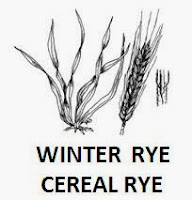Our first frost event happened on Friday morning. We are still sowing cover crop seeds so we headed off to the land first thing Saturday morning. We finished sowing 17 rows of oats, nitro radish and hairy vetch by 1 p.m. This was a good thing because the winds really began to kick up and by mid-afternoon, it was howling! The good news is that all of our cover crop seeds have been sown and even better, we had a rain event early Sunday morning. Hopefully the rain will aid in the germination of the seeds. We are alternating our 35 row vineyard with 2 mixtures of seeds: (1) winter oats bob, crimson clover and nitro radish and (2) winter rye, hairy vetch and nitro radish.
The following drawings and information comes from the online publication
Managing Cover Crops Profitably from the
Sustainable Agriculture Research and Education (SARE) site:
|
Oats or Avena sativa is a cool season annual cereal that is used for suppressing weeds, preventing erosion, scavenging excess nutrients, and adding biomass. |
|
Crimson clover or Trifolium incarnatum is a winter annual or summer annual legume that is used for providing a N source, building soils, preventing erosion, and reseeding inter-row ground cover. |
|
Winter (cereal) rye or Secale cereale is a cool season annual cereal grain that is used for scavenging excess N, preventing erosion, adding organic matter, and suppressing weeds. |
|
Hairy vetch or Vicia villosa is a winter annual or summer annual legume that is used for providing a N source, suppressing weeds, conditioning the topsoil, and reducing erosion. |
The other seed that is in both mixtures is called nitro radish. Nitro radish is also known as
Raphanus sativus, but we Japanese also know it as daikon. We incorporated nitro radish in our cover crop mixture because it is important as a bio-driller, biofumigant, and is also used in erosion control and nematode control, and is effective in nutrient scavenging.





No comments:
Post a Comment